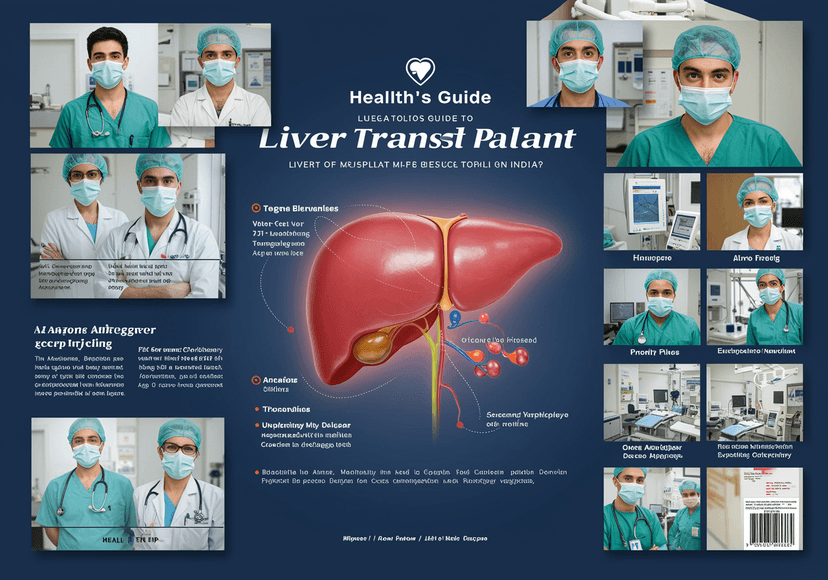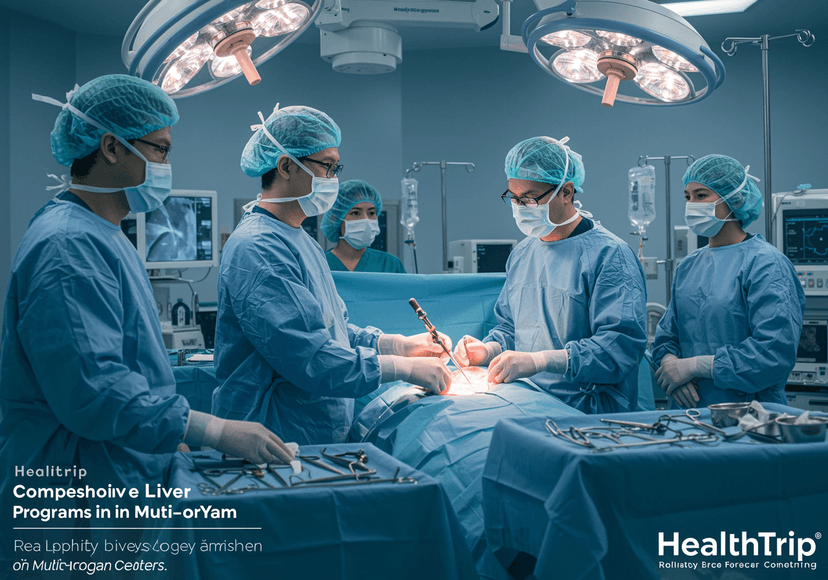
Auxiliary Liver Transplants: Benefits, Procedure, and More
16 Sep, 2023
 Healthtrip Team
Healthtrip TeamIntroduction
The field of organ transplantation has evolved significantly over the years, offering innovative solutions to save lives and improve the quality of life for patients facing critical organ failure. One such advancement is auxiliary liver transplantation, a complex and fascinating procedure that provides a ray of hope for individuals with severe liver diseases. In this comprehensive exploration, we delve into the world of auxiliary liver transplants, uncovering their benefits, the intricate procedures involved, and the remarkable impact they have on patients' lives.
Most popular procedures in India
A. Understanding Auxiliary Liver Transplants:
1. What is Auxiliary Liver Transplantation?
Auxiliary liver transplantation, often referred to as partial liver transplantation, is a highly specialized surgical procedure. It involves the transplantation of a small portion of a healthy liver, either from a living donor or a deceased donor, into a recipient whose own liver remains partially or entirely functional. The transplanted liver segment supplements the recipient's existing liver, providing vital support while allowing the recipient's liver to regenerate and regain functionality.
B. Benefits of Auxiliary Liver Transplants:
1. Life-Saving Intervention:
Auxiliary liver transplants are typically considered when a patient's liver function is severely compromised, but complete liver transplantation is not immediately necessary. This procedure offers a bridge to transplantation, allowing patients to stabilise and improve while awaiting a full liver transplant.
Wellness Treatments
Give yourself the time to relax
Lowest Prices Guaranteed!

Lowest Prices Guaranteed!
2. Liver Regeneration:
The human liver is a remarkable organ with the unique ability to regenerate. Auxiliary liver transplantation harnesses this regenerative capacity, enabling the recipient's liver to heal and regain function over time.
3. Reduced Risk of Rejection:
Since only a portion of the liver is transplanted, the risk of graft rejection is lower than in whole liver transplantation. This can be advantageous, particularly in cases where the patient's immune system is highly sensitised.
4. Minimised Donor Risk:
In living donor auxiliary liver transplantation, the donor provides a partial liver, typically a segment of their left lobe. This minimises the risk to the donor compared to full liver donation.
5. Shorter Wait Times:
Auxiliary liver transplantation can help patients receive life-saving treatment more quickly than waiting for a complete liver transplant, which can take longer due to organ availability.
C. The procedure of Auxiliary Liver Transplants:
The procedure for auxiliary liver transplantation is intricate and requires a highly skilled surgical team. Here's an overview of the steps involved:
1. Recipient Evaluation:
Before the surgery, the recipient undergoes extensive medical evaluation to assess their suitability for the procedure. This evaluation includes blood tests, imaging studies, and consultations with transplant specialists.
2. Donor Selection:
In cases of living donor auxiliary liver transplants, a suitable living donor is identified. Living donors are typically close relatives or individuals with a compatible blood type.
3. Liver Resection (Donor):
In living donor transplants, the donor undergoes a partial liver resection. This involves removing a segment of the left lobe, which is then prepared for transplantation.
4. Recipient Surgery:
The recipient is prepared for surgery, and the partial liver segment from the living or deceased donor is implanted into their abdomen, typically on the right side. The new liver segment is surgically connected to the recipient's blood vessels and bile ducts.
5. Recovery and Regeneration:
Over the following weeks and months, the transplanted liver segment gradually integrates with the recipient's own liver. The recipient's liver regenerates and starts to regain function.
6. Immunosuppressive Medications:
To prevent rejection of the transplanted liver segment, the recipient is prescribed immunosuppressive medications. These medications are carefully monitored and adjusted as needed.
7. Follow-Up Care:
Regular follow-up appointments and medical assessments are essential to monitor the progress of the transplanted liver segment and ensure the recipient's well-being.
D. Candidates for Auxiliary Liver Transplants:
Auxiliary liver transplantation is typically considered for individuals facing critical liver diseases, such as:
1. Acute Liver Failure:
Patients with acute liver failure, often due to drug toxicity, hepatitis, or other sudden causes, may benefit from auxiliary liver transplantation to support their failing liver while awaiting recovery or a complete liver transplant.
2. Chronic Liver Diseases:
Individuals with chronic liver diseases, including cirrhosis and hepatitis, may undergo auxiliary liver transplantation to stabilise their condition and improve liver function.
3. Metabolic Disorders:
Some metabolic disorders, such as certain types of urea cycle disorders, can be managed with auxiliary liver transplantation to provide healthy liver enzymes and metabolic function.
4. Genetic Liver Diseases:
Patients with genetic liver diseases, such as Alagille syndrome or progressive familial intrahepatic cholestasis, may benefit from auxiliary liver transplantation to alleviate symptoms and improve quality of life.
E. Outcomes and Considerations:
The success of auxiliary liver transplantation depends on various factors, including the recipient's overall health, the condition of the transplanted liver segment, and the expertise of the medical team. Here are some key considerations:
1. Liver Regeneration:
The regenerative capacity of the recipient's liver is a critical factor in the success of auxiliary liver transplantation. Some patients may experience significant liver regeneration and regain sufficient liver function to avoid the need for a complete transplant.
2. Immunosuppression:
Patients must adhere to immunosuppressive medications to prevent rejection of the transplanted liver segment. This requires careful management and regular monitoring.
3. Transplant Timing:
The timing of the procedure is crucial. Auxiliary liver transplantation is often considered as a bridge to a complete liver transplant. The decision to proceed with a full transplant may be made based on the recipient's progress.
4. Donor Safety:
In living donor auxiliary liver transplantation, the safety and well-being of the donor are paramount. Donors undergo thorough evaluations to ensure they can safely donate a portion of their liver.
5. Post-Transplant Care:
Long-term follow-up care is essential to monitor the recipient's liver function and overall health. Regular check-ups and medical assessments are crucial.
F. Patient Stories: Triumph over Liver Disease:
The impact of auxiliary liver transplantation on patients' lives cannot be overstated. Let's explore the journeys of two individuals who underwent this life-saving procedure.
1. Sarah's Remarkable Recovery
- Sarah, a 28-year-old teacher, faced a dire situation when she was diagnosed with acute liver failure due to a severe viral infection. Her liver function deteriorated rapidly, and she was deemed a candidate for auxiliary liver transplantation.
- "I was in a critical condition when I underwent auxiliary liver transplantation. My family was overjoyed when we found a suitable donor, my younger brother. The surgery went smoothly, and within weeks, I began to see improvements in my liver function.
- The most incredible part of the journey was witnessing my liver regenerate. It was like witnessing a miracle. Over time, my own liver regained enough function that I didn't need a full transplant. I consider myself incredibly fortunate.
- Today, I lead a normal life, free from the shackles of liver disease. My experience with auxiliary liver transplantation was a turning point, and I'm grateful for the medical team that made it possible."
2. David's Battle with Genetic Liver Disease
- David, a 12-year-old boy, was born with a rare genetic liver disease that affected his growth and quality of life. His parents explored various treatment options, and after consultation with experts, they decided on auxiliary liver transplantation.
- "We knew that auxiliary liver transplantation was our best hope for David to lead a healthy life. Finding a compatible deceased donor was a challenge, but we never gave up hope. When the surgery finally happened, it was nerve-wracking, but we had faith in the medical team.
- Watching David recover and thrive after the surgery was nothing short of a miracle. His growth improved, and his energy levels soared. We still have to manage his condition, but the transplant gave him a chance at a brighter future.
- The decision to opt for auxiliary liver transplantation was a life-changing one, and we are so grateful for the renewed hope it brought to our family."
Conclusion:
Auxiliary liver transplantation represents a remarkable achievement in the field of organ transplantation, offering a lifeline to individuals facing critical liver diseases. This procedure not only saves lives but also harnesses the regenerative potential of the human liver, allowing patients to regain their health and vitality. While auxiliary liver transplantation is a complex and intricate procedure, its potential to provide a bridge to recovery or a full transplant makes it a valuable option for patients in critical situations. As medical science continues to advance, the boundaries of what is possible in organ transplantation continue to expand, offering hope and healing to those in need.
Related Blogs

Healthtrip:Explore Kidney Treatment Options in Mecca: Hospitals & Costs Compared
Healthtrip

Healthtrip's Guide to Liver Transplant Medical Tourism in India
Complete Guide

Healthtrip: Your Guide to Leading Multi-Organ Transplant Centers
Healthtrip

Why Patients Choose India for Liver Transplants via Healthtrip
Healthtrip

Healthtrip: Comprehensive Liver Surgery Programs in Multi-Organ Centers
Healthtrip Transplant Centers

Healthtrip: Access World-Class Liver Transplant Specialists Globally
Medical Tourism Experts










